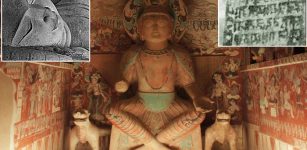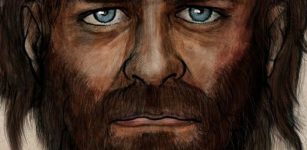Curious Ritual Wooden ‘Duho’ Stool Of Ancient Taino People
A. Sutherland - AncientPages.com - This ceremonial four-legged wooden stool known as 'duho' originates from Santo Domingo, Dominican Republic, and dates back to 1200– 1500 AD.
The grimacing, bizarre face of seat's half-human and half-animal creature. Image credit: British Museum
Scholars have long argued over the function of the Taino stool, which is not entirely known. However, the duho' was definitely not any domestic object for ordinary people.
Pre-Columbian duhos have their roots in the ancient tradition of the Taino culture, indigenous peoples of the Caribbean, what is today Haiti and the Dominican Republic), Puerto Rico, and the Bahamas.
People believed the "duho" stool possessed great power. It was carved into the shape of a weird, male creature, half-animal and half-human, with a large mouth, wide ears, and two arms, which form the front two legs of the stool. From there, a broad curve of wood sweeps upwards, supported by two more legs.
Underneath the creature and between the hind legs were carved male genitals, as described by researchers.
Many believe Taino shamans and chiefs used the artifact (only about the size of a footstool) during ceremonial communication with the spirit world.
According to José R. Oliver, a Puerto Rican/Catalan archaeologist specializing in the archaeology of the Caribbean, the duho was not a piece of furniture but rather a symbolic location of where the chief would stand, most probably a symbolic portal and a vehicle to the supernatural world.
A hallucinogenic snuff "Cohoba" prepared from the charred seeds of the cohoba tree and inhaled in a Y-shaped, twin-nasal pipe was used as a mind-altering substance. The effect of this snuff was experienced within half an hour and lasted from two to three hours, giving diverse special effects such as weird sounds, voices, and dream-like hallucinations.
By sitting on the duhos, chiefs could come in contact with the realm of the cemi (the spirit of the ancestor) and publicly display their power over the spirit world and their ability to manage and control the invisible forces governing the natural world as well as human affairs.
The Taino people believed they lived in parallel with an invisible world of ancestors and gods, from whom their leaders could seek knowledge of the future.
The Europeans who had an opportunity to see the Taino duho called it "the 'wood of life' ("lignum vitae"), which was believed to treat successfully many illnesses, from sore throats to syphilis.
Wooden four-legged stool carved in anthropomorphic form and inlaid with gold; called duho. Image credits: British Museum
The wood of the duho - smooth and perfect - originated from the Caribbean and was intentionally chosen and had remarkable qualities. It was so unusually dense that it could sink in water.
Not much is known about the Taino people. They lived in small settlements of a few thousand people, in large circular houses, each accommodating perhaps a dozen families, clustered around a central square. Their life was ruled by centers of power whose leaders fought, negotiated, and allied among themselves.
The Tainos' contact with the Europeans was fatal. Consequently, it brought enslavement, disease, and finally, the collapse of indigenous Taino society.
Many believe the artifact (only about the size of a foot stool) was used by Taino shamans and chiefs during ceremonial communication with the spirit world.
Written by – A. Sutherland AncientPages.com Staff Writer
Updated on July 22, 2022
Copyright © AncientPages.com All rights reserved. This material may not be published, broadcast, rewritten or redistributed in whole or part without the express written permission of AncientPages.com
Expand for referencesMore From Ancient Pages
-
 How Did Native American Indian Chiefs Get Their Names?
Ancient History Facts | May 27, 2016
How Did Native American Indian Chiefs Get Their Names?
Ancient History Facts | May 27, 2016 -
 On This Day In History: Turco-Mongol Emperor Timur Sacks Damascus – On Mar 24, 1401
News | Mar 24, 2017
On This Day In History: Turco-Mongol Emperor Timur Sacks Damascus – On Mar 24, 1401
News | Mar 24, 2017 -
 Selinunte: Latest Excavations Bring To Light A New Small Temple – What Ritualistic Practices Will Be Revealed One Day?
Archaeology | Aug 12, 2024
Selinunte: Latest Excavations Bring To Light A New Small Temple – What Ritualistic Practices Will Be Revealed One Day?
Archaeology | Aug 12, 2024 -
 Uncovering Ancient Secrets Hidden In China’s Dunhuang Caves
News | Jan 13, 2021
Uncovering Ancient Secrets Hidden In China’s Dunhuang Caves
News | Jan 13, 2021 -
 Five Ancient Mirror Frames, Ceramics Factory Found In Intriguing Roman Villa In Pavlikeni, Bulgaria
Archaeology | Mar 13, 2018
Five Ancient Mirror Frames, Ceramics Factory Found In Intriguing Roman Villa In Pavlikeni, Bulgaria
Archaeology | Mar 13, 2018 -
 People With Blue Eyes Have One Common Ancestor Who Appeared 10,000 Years Ago
Civilizations | Feb 24, 2017
People With Blue Eyes Have One Common Ancestor Who Appeared 10,000 Years Ago
Civilizations | Feb 24, 2017 -
 Is There An Ancient Secret Connection Between The Statue Of Liberty And The Anunnaki Goddess Inanna?
Featured Stories | Sep 28, 2018
Is There An Ancient Secret Connection Between The Statue Of Liberty And The Anunnaki Goddess Inanna?
Featured Stories | Sep 28, 2018 -
 How And When Did Ancient People Start Using Oil?
Ancient History Facts | Jun 28, 2018
How And When Did Ancient People Start Using Oil?
Ancient History Facts | Jun 28, 2018 -
 Ancient Roman Settlement Discovered In Deal, UK
Archaeology | Dec 16, 2022
Ancient Roman Settlement Discovered In Deal, UK
Archaeology | Dec 16, 2022 -
 On This Day In History: Mount Tambora Volcano Begins A Three-Month-Long Eruption – On Apr 10, 1815
News | Apr 10, 2017
On This Day In History: Mount Tambora Volcano Begins A Three-Month-Long Eruption – On Apr 10, 1815
News | Apr 10, 2017 -
 The Cyclades And Their Mysterious Society Lost In Time
Civilizations | Feb 4, 2016
The Cyclades And Their Mysterious Society Lost In Time
Civilizations | Feb 4, 2016 -
 Etruscan City Of Cerveteri With Magnificent House-Like Tombs Decorated With Scenes From Life And Death
Featured Stories | May 17, 2022
Etruscan City Of Cerveteri With Magnificent House-Like Tombs Decorated With Scenes From Life And Death
Featured Stories | May 17, 2022 -
 Non-Royal Elite Burial And Deciphered Hieroglyph Reveal Privileged And Hard Life Of Maya Ambassador
Archaeology | Mar 18, 2021
Non-Royal Elite Burial And Deciphered Hieroglyph Reveal Privileged And Hard Life Of Maya Ambassador
Archaeology | Mar 18, 2021 -
 Lake Titicaca Reveals More Ancient Underwater Secrets
Archaeology | Oct 11, 2013
Lake Titicaca Reveals More Ancient Underwater Secrets
Archaeology | Oct 11, 2013 -
 Rare 2000-Year-Old Celtic Figurine Among Finds In Cambridgeshire
Archaeology | Dec 18, 2018
Rare 2000-Year-Old Celtic Figurine Among Finds In Cambridgeshire
Archaeology | Dec 18, 2018 -
 Micro-CT Scans Revealed: It Wasn’t Egyptians’ Falcon-Headed Deity But Malformed Human Baby
Archaeology | Jun 2, 2018
Micro-CT Scans Revealed: It Wasn’t Egyptians’ Falcon-Headed Deity But Malformed Human Baby
Archaeology | Jun 2, 2018 -
 Has The Mystery Of Neanderthals’ Flower Burial At Shanidar Cave Been Solved?
Archaeology | Aug 31, 2023
Has The Mystery Of Neanderthals’ Flower Burial At Shanidar Cave Been Solved?
Archaeology | Aug 31, 2023 -
 Before Ragnarok: Horrifying Fimbulwinter In Norse Mythology Was Based On Real Events
Featured Stories | Nov 1, 2016
Before Ragnarok: Horrifying Fimbulwinter In Norse Mythology Was Based On Real Events
Featured Stories | Nov 1, 2016 -
 Golden Figurine From Yozgat Depicts Unknown Hittite God
Artifacts | May 11, 2016
Golden Figurine From Yozgat Depicts Unknown Hittite God
Artifacts | May 11, 2016 -
 Ivriz Relief: 3,000-Year-Old Hittite Relief – Oldest Known Symbol Of Agricultural Fertility In History
Artifacts | Jun 13, 2019
Ivriz Relief: 3,000-Year-Old Hittite Relief – Oldest Known Symbol Of Agricultural Fertility In History
Artifacts | Jun 13, 2019



